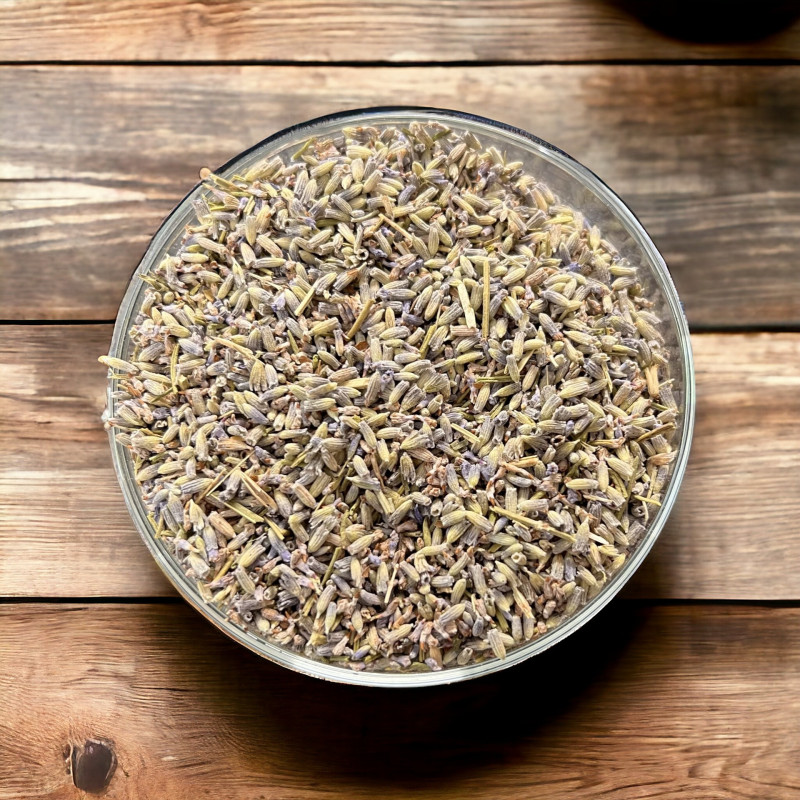
Reference: jasmin


The fragrance of lavender instantly evokes the sound of cicadas in the sunlit hills of Haute Provence in July.
It’s commonly used to scent closets, but also finds its place in the kitchen in pastries, ice creams, creams, biscuits, liqueurs, teas, bread, and even occasionally in saucy meat dishes.
 Delivery
Delivery
Mondial Relay
 Returns
Returns
See conditions
 Payments
Payments
100% secure
- Livré en sachet refermable -
Uses in Cooking and Beyond:
Lavender has a powerful, floral flavor with a slight bitterness that strongly resembles its aroma.
In cooking, if you’re not accustomed to using lavender, it's best to place the flowers in a small muslin bag or tea ball to easily remove them when the desired flavor is achieved. This prevents the taste from becoming overwhelming. For recipes where this isn’t possible (such as bread), infuse a small amount of lavender in a liquid used in the recipe (warm water, milk, syrup, etc.), adding it gradually and tasting frequently to control the flavor.
Lavender can also be used in small amounts to flavor liqueurs, as in a vermouth blend, or other spirits.
Lavender pairs wonderfully with jams, sauces for meat, and even mustard. It complements orange, Grand Marnier, honey, and goat cheese, on which a few flowers make an excellent garnish.
Dried lavender flowers retain their fragrance for a long time, making them popular for scenting closets. Note, however, that “lavender” in sachets often refers to lavandin, a less costly lavender hybrid with different cultivation requirements, though less suited for culinary use.
Who am I?
Origin: Albania/France/Germany
Scientific name: Lavandula angustifolia
Common names: True lavender, Alpine lavender, fine lavender
In perfumery, lavender scents everything from soap to detergents. It’s also used in creating classic colognes, primarily for men.
Lavender has calming, healing, and lice-repelling properties. Placed in a sachet under a pillow, it can help induce restful sleep.
Lavender is a member of the Lamiaceae family and the Lavandula genus, with mauve or violet flowers on spikes that can grow up to 0.5 meters tall. Its aromatic, fine foliage is evergreen, and its highly fragrant flowers are popular in perfumery and gastronomy. Lavender is also highly melliferous, producing a mild honey loved by bees, which is excellent for health. Flowers appear in July and August as small spikes on long, unbranched stalks, and they are harvested during this period.
"True" lavender is often mistaken for lavandin, a hybrid discovered and cultivated from the 1930s. Lavandin is more widely grown due to its higher essential oil yield and easier cultivation. However, its flavor is less pleasant in dishes. Lavandin differs by its flower stalk, which divides into three branches, each bearing a small spike, unlike true lavender with a single spike per stalk. True lavender grows at 500 to 1700 meters on sunny mountain slopes, while lavandin prefers plains. Higher altitudes produce better-quality lavender, with more intense color—a bluer lavender indicates higher quality.
Lavender thrives in dry, sunny, calcareous soil and is sometimes found wild, especially in Haute Provence. It is resilient to diseases and pests.
History:
The name "lavender" derives from the verb “to wash,” possibly from Italian "lavando" (washing) or the Latin "lavandaria" (laundry).
Native to the Mediterranean basin, lavender cultivation spread to Eastern Europe and even Canada, where hardy varieties can withstand severe frost.
Lavender was used by the Romans to scent their linens and baths. In Provence, it became popular in the Middle Ages for perfumes and medicines. Fumigations and poultices were made from lavender to combat the plague, as believed. Its cultivation expanded significantly in the 19th century, especially with the growth of the perfume industry in Grasse. In the 1950s, lavandin largely replaced true lavender in systematic cultivation.
Data sheet
Reference: jasmin
Reference: rosepetale
Reference: pellebuisG8
Reference: camomilleRom
Reference: 112390010
Reference: bleuet
Reference: mauve
Reference: rosepetale
Reference: rosepetale
Reference: 408190301
Reference: jasmin
Reference: 26545D
Reference: souci

The fragrance of lavender instantly evokes the sound of cicadas in the sunlit hills of Haute Provence in July.
It’s commonly used to scent closets, but also finds its place in the kitchen in pastries, ice creams, creams, biscuits, liqueurs, teas, bread, and even occasionally in saucy meat dishes.